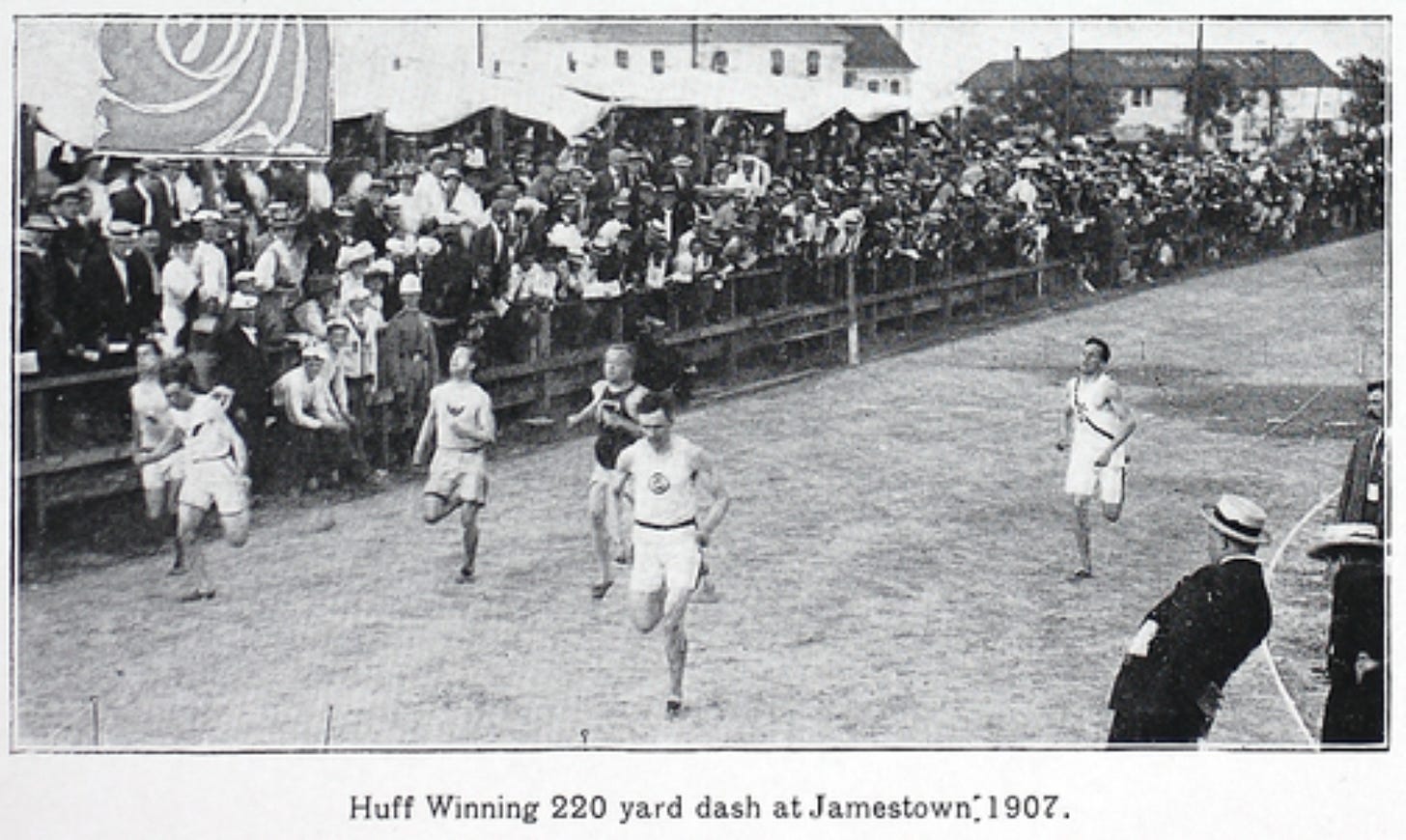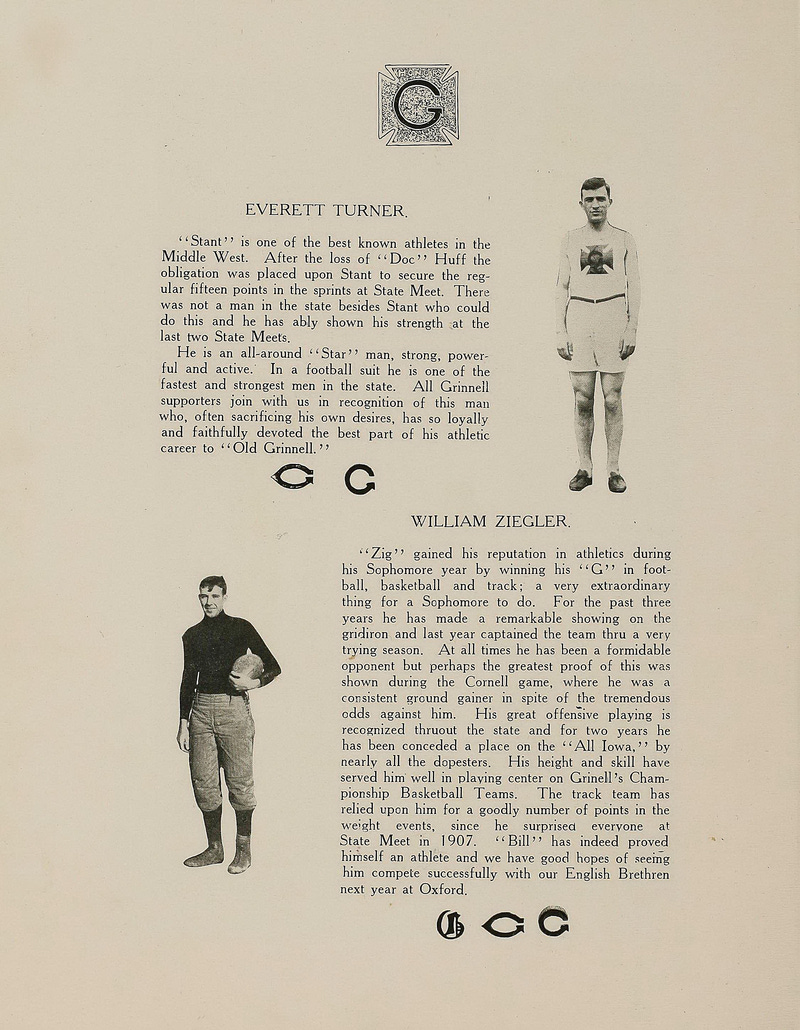A Yalie Coaches the 1908 Iowa College / Grinnell Team
The composite RPPC below shows the 1908 football team for Iowa College, a school most have never heard of, though it was the first liberal arts college west of the Mississippi. Founded in Davenport in 1846, it relocated to Grinnell, Iowa, in 1858. They renamed it Grinnell College in 1909, making the pictured players the last to take the field under the Iowa College banner, though newspapers commonly referred to the school and team as Grinnell long before the formal name change.
Iowa College / Grinnell has a proud football past. Their 1889 game with Iowa was the first collegiate football game west of the Mississippi and they often played schools far bigger than themselves, as evidenced by their membership in the Missouri Valley Conference from 1918 to 1939, along with Kansas, Missouri, Nebraska, Iowa State, and others.
The 1908 team was typical of their teams early in the last century, working under rookie coach Leon H. Andrews, a sometime starter on the Yale teams of 1903 and 1905, who coached the Yale freshman in 1907. Like many before him, Andrews was an Easterner who headed west to sprinkle his football magic on the Iowa sodbusters.
Andrews arrived in Grinnell in mid-September, just two weeks before Iowa College's first game, though some team members were already working out under the captain's direction by then. It’s a good bet Andrews spent part of his first week on campus trying to convince Harry Huff to play football. Huff, who won the 1907 AAU championships and ran the 100 and 200 meters at the 1908 Olympics in London, was a no-go, choosing to coach the school's track team instead.
The early returns on Andrews were positive. Observers viewed him as a technician whose words instilled ginger in his boys. Just over a week after arriving, Iowa College played East Des Moines High. Despite missing several injured players and having scrimmaged little to that point, they won handily, 28-0, in a game of 15-minute halves, giving the veteran team an early sense of what they might become. The Scarlet and Black followed the victory over the prepsters with a 51-0 trouncing of Leander Clark to set themselves up for the battle in Lincoln versus Nebraska. While optimism abounded, two expected starters were out for the year with injuries, and their quarterback, who also kicked and punted, was on double-secret academic probation.
Coach Andrews, who presumably had never crossed the Mississippi until arriving at Grinnell, led his boys into the home of the Bugeaters without a scouting report, film, or other insight into what they faced. Upon arriving in Lincoln on Friday, he told the press:
I have never seen Nebraska in action, so I would be foolish to attempt to dope the results for tomorrow. I will say, however, that the team is in first class shape, and that we will go into the game with every hope of making the Nebraskans know we are there, and of making them fear us before the game is over.
'Eliot Watches Minnesota,' Lincoln Journal Star, October 11, 1908.
Andrews, who had several fast ends, installed new forward passing plays, and opened the game through the air, taking Nebraska by surprise and allowing Grinnell to score first. Nebraska answered with a strong run game, scoring three touchdowns, each benefitting from a fumble by Iowa College's new quarterback, as the Nebraskans left the field with a hard-earned 20-5 victory.
Creighton came next. Unfortunately, the favored Iowegians missed multiple opportunities inside the 10-yard line, losing 8-7.
Standing 2-2, the Iowa College boys prepared for one of their top games of the year versus Drake. Drake was their rival among teams aspiring to big-time football, while the season-ender with Cornell College was the rival among the small college set. Unfortunately, while Drake failed to score on Iowa College the two previous years, the tables turned this time around as Drake emerged with a 9-0 victory.
Easy victories over Coe and Des Moines College followed, leading to a contest with Iowa State. Iowa State had beaten Missouri, while losing close to Minnesota, Cornell College, and Nebraska, so the Iowa College boys knew they had a chance in Ames. However, the chance was short-lived as Iowa State walloped Iowa College 53-0.
Coming off the trouncing, Iowa College could save its season in the Cornell College matchup, a team they had beaten nine years in a row. Things did not look good for the Iowa College boys in the first half when Cornell took an 11-0 lead, but Cornell left the door ajar by missing one of their extra point attempts. Iowa College pushed open that door in the second half, scoring a touchdown to end a long drive, and picking up a second touchdown when Cornell fumbled a punt with the Scarlet and Black recovering it in the end zone. Since Iowa College made both extra points, and Cornell missed four field goals that afternoon, Cornell lost for the tenth time in a row, 12-11.
The win salvaged Iowa College's last season under that name. They were officially Grinnell College for their next season, and did their best to compete with bigger boys until shortly before WWII, when they opted to pick on schools their own size.
Coach Leon Andrews returned to the East, where he coached a prep team or two before returning to college coaching as an assistant at Texas A&M in 1910. He went right back East after the season, entered the insurance industry, and kept his hand in the game, officiating big-time football games through the mid-1920s.
That's the end of the core story, but the research for this story found another fun bit of minutiae. An irritant related to researching pre-WWI teams is that college yearbooks then did not work quite like today. That is, the yearbook covering the 1908 season was often not the 1909 yearbook, but the 1910 yearbook. The junior class (the Class of 1910) produced it for the senior class, yet it was named for the junior class. Some schools did it the junior class way, and others like we do today, so you never know which yearbook to look at when searching for coverage of a particular year's team.
Since I did not know which approach Iowa College used, I virtually flipped through several. While I never found an action image of the 1908 team to use with this story, the 1911 yearbook included multiple pages displaying images and bios won by each letterman, along with the letters they won.
As discussed in an earlier Tidbit, some schools of the era had different letter typefaces for each sport. The letter earned for one sport might be serif, another non-serif, while a third used the Olde English or Germanic look. So, multi-sport G men like Everett Turner and William Ziegler earned letters of varying designs. That's some multi-layered minutiae there, but it is another simple illustration that practices we take for granted today were not always followed in earlier times.
Of course, another example that times are a changin’ is that schools used to gain status by hiring a recent Yale grad as their coach. While Yale graduates such as Dick Jauron and Mike McDaniel became NFL head coaches in recent decades, I could not find a Yale graduate who became a major college head coach since the relegation of Yale and the other Ivies to DI-AA/FCS in 1982. Let us know if you are aware of one.
Click Support Football Archaeology for options to support this site beyond a free subscription.






